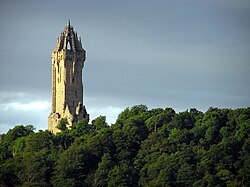Difference between revisions of "Wallace Monument"
(Created page with "{{Infobox building |name=The Wallace Monument |county=Perthshire |picture=Wfm wallace monument.jpg |picture caption=The Wallace Monument |os grid ref=NS80919565 |latitude=56.1...") |
(No difference)
|
Latest revision as of 21:28, 28 June 2021
| The Wallace Monument | |
|
Perthshire | |
|---|---|
 The Wallace Monument | |
| Type: | Tower monument |
| Location | |
| Grid reference: | NS80919565 |
| Location: | 56°8’19"N, 3°55’5"W |
| History | |
| Built 1861-1869 | |
| By: | John Thomas Rochead |
| Tower monument | |
| Information | |
The Wallace Monument is a grand tower standing on the shoulder of the Abbey Craig, a hilltop in the very south of Perthshire overlooking Stirling. It commemorates Sir William Wallace, a 13th- and 14th-century Scottish hero.[1]
It stands 220 feet high; a sandstone tower built in the Victorian Gothic style.
The tower is at the edge of Causewayhead, the northern suburb of Stirling, in the pocket where Stirlingshire bulges north of the River Forth, and spilling over into Perthshire on the western slope of Abbey Craig.
The tower is open to the public for an admission fee. Visitors approach by foot from the base of the crag on which it stands. On entry there are 246 steps to the final observation platform, with three exhibition rooms within the body of the tower. The tower is not accessible to disabled visitors.[1]
Background
The tower was constructed following a fundraising campaign, which accompanied a resurgence of romanticism in the 19th century. The campaign was begun in Glasgow in 1851 by Rev Charles Rogers who was joined by William Burns. Burns took sole charge from around 1855 following Rogers' resignation. The design was by the architect John Thomas Rochead.
In addition to public subscription, it was partially funded by contributions from a number of foreign donors, including the Italian revolutionary leader Giuseppe Garibaldi. The foundation stone of the 'National Wallace Monument' was laid in 1861 by the Duke of Atholl in his role as Grand Master Mason of Scotland, with a short speech given by Sir Archibald Alison.[2] It was completed in 1869
Form
The tower stands on the Abbey Craig, a volcanic crag above Cambuskenneth Abbey, from which Wallace was said to have watched the gathering of the army of King Edward I of England just before the Battle of Stirling Bridge in 1297. The monument is open to the general public. Visitors climb the 246-step spiral staircase to the viewing gallery inside the monument's crown, which provides expansive views of the Ochil Hills and the Forth Valley.
A number of artifacts believed to have belonged to Wallace are on display inside the monument, including the Wallace Sword, a 5-foot longsword weighing six pounds.[3] Inside is also a Hall of Heroes, a series of busts of famous Scots, effectively a small Hall of Fame. The heroes[4] are Robert the Bruce, George Buchanan, John Knox, the poets Allan Ramsay and Robert Burns, Robert Tannahill, Adam Smith, James Watt, Sir Walter Scott, William Murdoch, Sir David Brewster, Thomas Carlyle, Hugh Miller, Thomas Chalmers, David Livingstone, and W. E. Gladstone.[5] In 2017 it was announced that Mary Slessor and Maggie Keswick Jencks would be the first heroines to be celebrated in the hall.[6]
Statue of Wallace
The original Victorian statue of Wallace stands on the corner of the monument and is by the Edinburgh sculptor David Watson Stevenson.[7]
Outside links
| ("Wikimedia Commons" has material about Wallace Monument) |
References
- ↑ 1.0 1.1 "The National Wallace Monument". https://www.yourstirling.com/see-do/the-wallace-monument/.
- ↑ Logie: A Parish History, Menzies Fergusson, 1905
- ↑ "Scottish Wars of Independence". BBC Scotland. http://www.bbc.co.uk/scotland/education/as/warsofindependence/info.shtml?loc=sword.
- ↑ Shearer's Stirling: historical and descriptive, with extracts from Burgh records and Exchequer Roll volumes, 1264 to 1529, view of Stirling in 1620, and an old plan of Stirling. Stirling: R.S. Shearer & Son. 1897. p. 114. https://archive.org/stream/shearersstirling00rssh#page/114/mode/1up/search/%22hall+of+heroes%22. Retrieved 24 June 2017.
- ↑ "Hall of Heroes". http://www.nationalwallacemonument.com/the-monument/the-hall-of-heroes/.
- ↑ "Scotland's Heroines – marking their place in history". http://www.nationalwallacemonument.com/scotlands-heroines/.
- ↑ "David Watson Stevenson RSA - Mapping the Practice and Profession of Sculpture in Britain and Ireland 1851-1951". https://sculpture.gla.ac.uk/view/person.php?id=msib6_1210848700.
